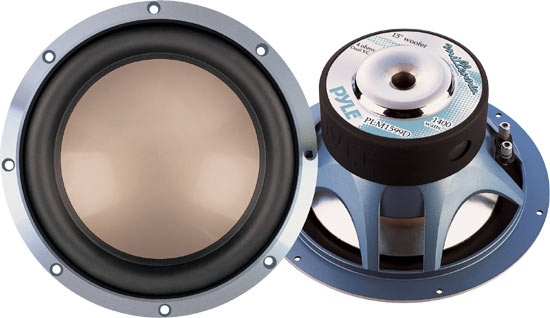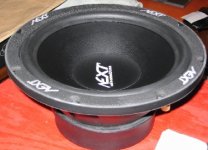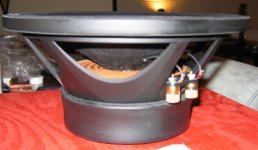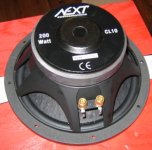I'm building a pair of H-Frame dipole woofer with some budget 10" drivers I picked up.
From pictures I've seen it looks like the wires pass through the baffle. I just want to make sure okay to drill a small hole in the baffle to pass wires through.
Also, I'm wondering about the active EQ. I'm using drivers that have a fairly low Qts. Linktwitz mentions that for the Peerless 830500 (which also has a low Qts) you need extra equalization beyond the 6db/oct but doesn't mention what. Is it on his site somewhere, or am I supposed to buy the MT1 PCB & documentation to find out? Do any of you out there know what sort of EQ I might need.
thanks a bunch 😀
From pictures I've seen it looks like the wires pass through the baffle. I just want to make sure okay to drill a small hole in the baffle to pass wires through.
Also, I'm wondering about the active EQ. I'm using drivers that have a fairly low Qts. Linktwitz mentions that for the Peerless 830500 (which also has a low Qts) you need extra equalization beyond the 6db/oct but doesn't mention what. Is it on his site somewhere, or am I supposed to buy the MT1 PCB & documentation to find out? Do any of you out there know what sort of EQ I might need.
thanks a bunch 😀
1. Yes, you can drill a small hole to pass wires through.
2. There's no way to answer your second question until you identify the Qts and response of your particular driver. The Q-correction equalization for the 830500 is 8Hz-80Hz (20db gain.) This equalizes the Q to approximately 0.5 from 0.2. If your drivers Qts is similar then you're probably in the ball park.
Cheers,
Davey.
2. There's no way to answer your second question until you identify the Qts and response of your particular driver. The Q-correction equalization for the 830500 is 8Hz-80Hz (20db gain.) This equalizes the Q to approximately 0.5 from 0.2. If your drivers Qts is similar then you're probably in the ball park.
Cheers,
Davey.
Is that 20db independent of frequency?
Here's the driver I'm using:
Fs 26.6 hz
Re 3.2 ohm
Qts 0.23
Qes 0.24
Qms 5.7
Vas 2.2 ft3
Sd 346 cm2
Xmax 13 mm (p-p)
Thanks again for the help!
Here's the driver I'm using:
Fs 26.6 hz
Re 3.2 ohm
Qts 0.23
Qes 0.24
Qms 5.7
Vas 2.2 ft3
Sd 346 cm2
Xmax 13 mm (p-p)
Thanks again for the help!
No, it's not independent of frequency. The 8-80Hz I mentioned for the 830500 is specific to that driver. Yours will be different (higher in frequency.) You'd need to measure to verify.
The 10" driver you listed with Xmax of 6.5mm will have limited output capability in a dipole configuration relative to some other 10" drivers that have twice that much. You're going to use up that Xmax very quickly when you apply both Q-correction and dipole correction to the system. You SPL capability will be pretty low.
I take it you're aware of this, and this is a get-your-feet-wet project?
Cheers,
Davey.
The 10" driver you listed with Xmax of 6.5mm will have limited output capability in a dipole configuration relative to some other 10" drivers that have twice that much. You're going to use up that Xmax very quickly when you apply both Q-correction and dipole correction to the system. You SPL capability will be pretty low.
I take it you're aware of this, and this is a get-your-feet-wet project?
Cheers,
Davey.
Yeah, I realize the limited output. But I got these 4 drivers for $100 shipped to my door, so I figured I'd give it a shot just to hear what this dipole bass is all about. I tend to listen at fairly low levels anyways.
WHOA... never mind on that X-max number though. When I bought them, the person told me 12mm xmax, and I assumed that was p-p. But I'm just reading the manual now and it says the xmax is 2.4cm! So i guess 12mm is just one way! Yippee, extra travel 😀 I've attached some pictures of the driver for your viewing pleasure.
Also, I when I said frequency dependent. What I meant to ask is, is that 20db just a constant gain applied, or does it has some sort of slope (sorry, I'm still learning about EQs, so I'm a bit confused). Or is it 20db constant gain on top of the 6db/octave standard
Thanks again 🙂
WHOA... never mind on that X-max number though. When I bought them, the person told me 12mm xmax, and I assumed that was p-p. But I'm just reading the manual now and it says the xmax is 2.4cm! So i guess 12mm is just one way! Yippee, extra travel 😀 I've attached some pictures of the driver for your viewing pleasure.
Also, I when I said frequency dependent. What I meant to ask is, is that 20db just a constant gain applied, or does it has some sort of slope (sorry, I'm still learning about EQs, so I'm a bit confused). Or is it 20db constant gain on top of the 6db/octave standard
Thanks again 🙂
Attachments
Santiu,
The 20db gain is a 6db/octave slope from a (6db/octave equals 20db/decade) 8-80Hz shelving filter. The 8Hz and 80Hz define the 3db points where the shelf begins and ends. (At 80Hz the response would be +3db and at 8Hz the response would be +17db.)
The dipole correction will also be a 6db/octave shelving filter, but it may not "line up" over the same frequency range you need for the Q correction. This will depend upon the shape/size of the H-baffle you create. A nominal value for baffles similar to the Linkwitz-sized ones would be 20Hz-320Hz which is a four octave range which means the 6db shelving filter would have a gain of 24db.
To implement this you'd build two shelving filters one 8-80 (20db gain) and one 20-320 (24db gain) and cascade them together to achieve the final result. At low frequencies you'd be boosting 44db, and somewhere in the middle of those two filters the slope would be 12db/octave...you can see where the very large excursion requirements come from. 🙂
The surround on those drivers looks fairly small to me.
I would hook those up in free-air initially and play a 20-30Hz tone through them at excursions near the rated Xmax to see if they make any aerodynamic noise. Drivers that are acceptable for dipole usage are very quiet with this test.
Cheers,
Davey.
The 20db gain is a 6db/octave slope from a (6db/octave equals 20db/decade) 8-80Hz shelving filter. The 8Hz and 80Hz define the 3db points where the shelf begins and ends. (At 80Hz the response would be +3db and at 8Hz the response would be +17db.)
The dipole correction will also be a 6db/octave shelving filter, but it may not "line up" over the same frequency range you need for the Q correction. This will depend upon the shape/size of the H-baffle you create. A nominal value for baffles similar to the Linkwitz-sized ones would be 20Hz-320Hz which is a four octave range which means the 6db shelving filter would have a gain of 24db.
To implement this you'd build two shelving filters one 8-80 (20db gain) and one 20-320 (24db gain) and cascade them together to achieve the final result. At low frequencies you'd be boosting 44db, and somewhere in the middle of those two filters the slope would be 12db/octave...you can see where the very large excursion requirements come from. 🙂
The surround on those drivers looks fairly small to me.
I would hook those up in free-air initially and play a 20-30Hz tone through them at excursions near the rated Xmax to see if they make any aerodynamic noise. Drivers that are acceptable for dipole usage are very quiet with this test.
Cheers,
Davey.
exipnos, I bought these from an individual, so sorry, I don't have a source for you. They are made by NEXT in germany, which I believe is a company owned by FIAMM. Here's some more details on their products: http://www.fiamm.com/en/3/prod.php/22;224 (too bad the guy didn't have any of the AL woofers. Those frames look nice and open)
Davey, thanks again for all your help. Yeah, you are right, the frames look a bit constricting. Luckily, with only $100 invested in drivers, I'm not worried if I get less than optimal results. I guess I'll just deal with having limited excursion (and consequently levels) due to any aerodynamic noise I might get. Hopefully, I can get some non-ugly sound out of them at 30.87hz.
Hopefully I can get these things built before the end of the year (things just always get so busy around the holidays).
Anybody have any suggestions for free or cheap speaker measuring software for Macs (preferably something that runs under OS X)? I think I want to build the microphone listed on Linkwitz site and try to measure the response I'm getting with these uber cheap dipole woofers.
Thanks again for all your help 😀 I'll keep you all posted as I make progress
Davey, thanks again for all your help. Yeah, you are right, the frames look a bit constricting. Luckily, with only $100 invested in drivers, I'm not worried if I get less than optimal results. I guess I'll just deal with having limited excursion (and consequently levels) due to any aerodynamic noise I might get. Hopefully, I can get some non-ugly sound out of them at 30.87hz.
Hopefully I can get these things built before the end of the year (things just always get so busy around the holidays).
Anybody have any suggestions for free or cheap speaker measuring software for Macs (preferably something that runs under OS X)? I think I want to build the microphone listed on Linkwitz site and try to measure the response I'm getting with these uber cheap dipole woofers.
Thanks again for all your help 😀 I'll keep you all posted as I make progress
Probably made in China at the same factory that churns out many brands (see pic). The AL drivers do look interesting with the vented gap cooling. Like Davey suggested, run some 20-30hz tones into the driver holding it in your hand (not too loud now🙂 -you don't want to damage it). If it's relatively quiet - you're set.
If you can hear air chuffing from the smallish rear vent, there is a solution. You can drill a small hole (1/2-3/4") in the dust cap, with the driver facing downwards and a vacuum handy to suck out any debri. Glue a small disc (1") of grill cloth or breathable foam to cover the hole. This will allow air in under the cap from the front of the driver and slow the velocity of air being pushed/pulled out the vent. If it's suspension noise, then you could add a light amount of fill into the rear of your H.
You didn't mention how high you need it to go. The lower the XO you need, the deeper you can make the frame to gain a bit of output.
Good luck.
Cheers,
AJ

If you can hear air chuffing from the smallish rear vent, there is a solution. You can drill a small hole (1/2-3/4") in the dust cap, with the driver facing downwards and a vacuum handy to suck out any debri. Glue a small disc (1") of grill cloth or breathable foam to cover the hole. This will allow air in under the cap from the front of the driver and slow the velocity of air being pushed/pulled out the vent. If it's suspension noise, then you could add a light amount of fill into the rear of your H.
You didn't mention how high you need it to go. The lower the XO you need, the deeper you can make the frame to gain a bit of output.
Good luck.
Cheers,
AJ

yup... looks like the same factory!
can I really do this test without mounting it to a baffle? If so, that would be GREAT! a lot less work for me. If so I can do that test tonight (just need to put some test tones on a CD as I don't have a signal generator I can use).
Drilling sounds a little scary, but doesn't seem to complicated. Basically just a little hole in the center of the cone right (since the dust cap is affixed to the cone?).
As for how high it needs to go. Well, I didn't mention that because I don't quite know. At first they will be crossed over to Wayne J.'s DBP's, since those are my speakers at the moment. So that crossover would be pretty high. However, this is just for playing around so I get to hear what they sound like. Once I finish building these woofers I was going to get started on a pair of back loaded horns with the Fostex FE108EZ using the fostex recommended enclosure. So ideally, I would like to have them designed to x-over to those speakers. There I'm not sure where I would crossover, but looking at the response on the plans, it seems like the x-over point would around 100 Hz. But then again, I have no idea what I'm doing, so that may be way off 😛
Unfortunately I don't want to make the frame too deep to save space (since they already have to be 3 ft away from the back wall.). Any suggestions on how deep to make the H-frame? I messed around with the spl_max spreadsheet. But to be perfectly honest I don't have a feeling for sound levels, and consequently, I'm having a hard time interpreting the results.
Thanks again for all this help... you guys are awesome!
can I really do this test without mounting it to a baffle? If so, that would be GREAT! a lot less work for me. If so I can do that test tonight (just need to put some test tones on a CD as I don't have a signal generator I can use).
Drilling sounds a little scary, but doesn't seem to complicated. Basically just a little hole in the center of the cone right (since the dust cap is affixed to the cone?).
As for how high it needs to go. Well, I didn't mention that because I don't quite know. At first they will be crossed over to Wayne J.'s DBP's, since those are my speakers at the moment. So that crossover would be pretty high. However, this is just for playing around so I get to hear what they sound like. Once I finish building these woofers I was going to get started on a pair of back loaded horns with the Fostex FE108EZ using the fostex recommended enclosure. So ideally, I would like to have them designed to x-over to those speakers. There I'm not sure where I would crossover, but looking at the response on the plans, it seems like the x-over point would around 100 Hz. But then again, I have no idea what I'm doing, so that may be way off 😛
Unfortunately I don't want to make the frame too deep to save space (since they already have to be 3 ft away from the back wall.). Any suggestions on how deep to make the H-frame? I messed around with the spl_max spreadsheet. But to be perfectly honest I don't have a feeling for sound levels, and consequently, I'm having a hard time interpreting the results.
Thanks again for all this help... you guys are awesome!
Santiu,
Take a look at the woofer section of my el-cheapo dipole system for a nominally sized H-baffle that should work okay for your setup.
http://home.comcast.net/~dreite/Davey/Davey.htm
The baffle and top/bottom sections are 11" X 23". The 11" depth gives a good compromise between EQ requirement and physical size.
Cheers,
Davey.
Take a look at the woofer section of my el-cheapo dipole system for a nominally sized H-baffle that should work okay for your setup.
http://home.comcast.net/~dreite/Davey/Davey.htm
The baffle and top/bottom sections are 11" X 23". The 11" depth gives a good compromise between EQ requirement and physical size.
Cheers,
Davey.
Well, I played a 30hz test tone and turned it up while just holding on the woofer. I have no clue how to tell how far the cone was moving, but it was a fair amount, although I don't think I hit the maximum travel (I actually probably only got 1/2 way there, I was too afraid of breaking the woofer). Anyhow, I didn't hear any noise other than the note being emitted by the woofer. Maybe I just don't know what I'm trying to listen for...
Are there any downsides to going ahead an putting the "vent" in the dust cap anyways?
Davey, thanks for the dimensions. I think I'll go with that. BTW, did you design those PCBs yourself? Also, which model Hammond chassis is that? I like it 🙂
Are there any downsides to going ahead an putting the "vent" in the dust cap anyways?
Davey, thanks for the dimensions. I think I'll go with that. BTW, did you design those PCBs yourself? Also, which model Hammond chassis is that? I like it 🙂
AJinFLA - Those are good looking drivers! Do they sound good? How much? Are they the same as the Pyle drivers you recommended in the most bang for the buck thread?
Cheers,
Exipnos
Cheers,
Exipnos
AJinFLA - Those are good looking drivers! Do they sound good?
I have no clue, those are just pictures that I recognized as being similar to the drivers Santui has.
How much? Are they the same as the Pyle drivers you recommended in the most bang for the buck thread?
No, these are old model Pyles that have been discontinued. The ones in my max bang thread are still available.
That said, the 12" version (PLM1299) of these Pyle AL drivers were rated as a best buy by a german car mag. If you could find some cheap, they may actually be decent drivers for dipole use - especially the 15's.
Cheers,
AJ
santiu said:
Davey, thanks for the dimensions. I think I'll go with that. BTW, did you design those PCBs yourself? Also, which model Hammond chassis is that? I like it 🙂
Yep.
The Hammond enclosure is part # HM736-nd at Digikey.com
Cheers,
Davey.
okay, one last question, I promise (at least for this project)!
Do I need to flush mount the woofers? Does it make a difference?
thanks again, and you guys are awesome (what would a newbie like me do with out a place like this?)
Do I need to flush mount the woofers? Does it make a difference?
thanks again, and you guys are awesome (what would a newbie like me do with out a place like this?)
santiu said:
Do I need to flush mount the woofers? Does it make a difference?
No. In fact it's better if you don't.....more meat for the screws. If you don't have a router you can cut the circles freehand with your jigsaw or rig a little jig that allows your saw to swing around in a circle.
Turn the computer off and fire up the table saw and have fun. 🙂
Davey.
Depth of H-baffle
The depth of the sides of the H-baffle does make a difference. The deeper the sides, the lower in frequency that the baffle starts to roll off. Information is available on Linkwitz's webpage which informs you on how to calculate the frequency at which the baffle begins to roll off. You can use the baffle roll off frequency as part of your crossover strategy.
However, the deeper the sides, the more resonance that the sides will make. Thus, don't make the baffle as deep as possible. To help keep the front and side baffles from moving/resonating too much, you might want to double up on the wood (2 x 3/4 inch).
I have woofers mounted on open baffle. I initially had a pair of 15 inch drivers on open baffle in an H-baffle. I could get down flat to 45 hz or so without too much cone movement when playing Bermester's Chinese Drums piece. I then added a pair of Avalanche 18s mounted in a W-baffle. I can now get down flat to perhaps 25 hz or so. Open baffle bass is very excellent, even with less expensive drivers.
Retsel
The depth of the sides of the H-baffle does make a difference. The deeper the sides, the lower in frequency that the baffle starts to roll off. Information is available on Linkwitz's webpage which informs you on how to calculate the frequency at which the baffle begins to roll off. You can use the baffle roll off frequency as part of your crossover strategy.
However, the deeper the sides, the more resonance that the sides will make. Thus, don't make the baffle as deep as possible. To help keep the front and side baffles from moving/resonating too much, you might want to double up on the wood (2 x 3/4 inch).
I have woofers mounted on open baffle. I initially had a pair of 15 inch drivers on open baffle in an H-baffle. I could get down flat to 45 hz or so without too much cone movement when playing Bermester's Chinese Drums piece. I then added a pair of Avalanche 18s mounted in a W-baffle. I can now get down flat to perhaps 25 hz or so. Open baffle bass is very excellent, even with less expensive drivers.
Retsel
- Status
- Not open for further replies.
- Home
- Loudspeakers
- Subwoofers
- Couple Simple Dipole Question...


